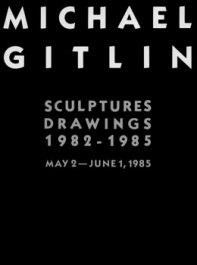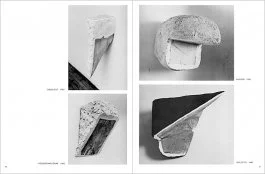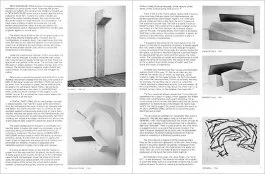Exit Art 1985
A Space Opens in the Work of Michael Gitlin
by Steven Henry Madoff
Michael Gitlin’s new sculpture is mostly wall-specific sculpture. When something is placed against a wall, it must struggle against the flat breadth of this supporting surface, which is adjacent to the floor. And it must struggle against the floor; that is to say against gravity. The art object against the wall and above the floor can get flattened out or it can push out or it can get dragged downward.
As Gitlin’s sculpture is not a painting (or any kind of representation involved in questions of pictorial illusion versus literal planar flatness), it asserts most emphatically its physical extension into space; its three-dimensional presence. But because the sculpture is attached to the wall, it also excites its two dimensional appearance—it shows its outlines repeatedly. It seems drawn in space. And it is always drawn in relation to the body. The body circumscribes the scale of the physical art object projecting from the wall because the object is not architecture and it is not monumental.
It is drawing in space limited by the wall. Also, it is a physical projection around the space of the body that is referred to, drawn out of the body, but which does not literally include the body because the body is absent. The absent body is a column of energy. It turns the way a dancer turns, from the center of the body, projecting out into the limbs. The body may be absent in its physical turning. But it is present because it is drawn around by the sculpture and it is held in tension by the wall.
In Gitlin’s more recent work (the exhibition begins with earlier pieces), the wooden forms are sawed, bent and hammered into an enclosing site, like a theater, in which the absent body as an envelope of space moves against its perimeters. These forms turn out from the wall. They act against each other. You can step inside of them, inside GREEN OPEN ENCLOSURE (1983), for example, with its four parts.
GREEN OPEN ENCLOSURE has one element rising from the floor. As the wall pulls the work back into its planar field, the floor’s sweeping horizontal implies the work’s de-scent. This one element of GREEN OPEN ENCLOSURE pulls the other elements into the floor. It draws them down on the turn. A body can step into the space between the parts, and it can turn there. Where the eye turns, it sees the work differently. It can see the crude boxes that are made by soaking the plywood planks and molding them, by fastening them almost bruskly together. The seams, the structures are exposed.
This appears to be modernist work, for the modernist work typically turns its structure out to the eye. The structural exposure is a way of directing the viewer’s attention. The seams become lines. They are the details of the drawing at the same time that they exert their physicality, which has a rough, expressionistic presence. The work is full of angles, trajectories and junctures designed to expose the virtual rather than the unified; to present the work as an attach-ment of parts in a calculated state of unrest.
As the sculpture emphasizes its parts, it lays out its particular aesthetic ground. It is not Minimalist. It pays no attention to Donald Judd’s dictum that “the big problem is that anything that is not absolutely plain begins to have parts in some way. The thing is to be able to work and do different things and yet not break up the wholeness that a piece has.” (1)
But I should say that there is another problem. The problem is the belief that plainness, in any way but the most cosmetic, bespeaks unity. The sculpture, whatever its surface appearance, exists in a spatial relation to the body. It is made to be seen and to act in dialogue with perceiving beings. It is made to be seen by bodies moving around it in space. All bodies move. Perceptually, they change size in relation to each other, advancing and receding. They turn. The space is always changing in relation to the work. No single unity exists.
The problem is that Judd believes in fundamental wholeness. But his whole object, his “specific object” is illusionary. No doubt, it is a Utopian concept. It does not exist without reducing the mind and the eye to a nostalgic exhortation of unified being. Judd wants to have specific gravity, to be in the world. But unity is not in the world any longer, unless you break every thing into its smallest, most individuated elements and isolate them. And that is not unity in the world. That is fragmentation.
Gitlin breaks up the wholeness. In his sculpture, space and the object always have parts. The body moves inside the work, leaving a mark in the materials surrounding it, leaving a space at the center. The outline of the work is, in fact, a contour. The work that is against the wall (fighting the flatness of the wall, pinned against it and coming out of it) is always turning away from specificity. It is mostly an outline of energy. In this it is reminiscent of Heinrich Wölfflin’s perception of Baroque sculpture: “The Baroque negates the outline: not in the sense that the silhouette effects are excluded altogether, but the figure evades consolidation within a definite silhouette. It cannot be tied down to a particular view [...] No view completely exhausts the form.” (2)
In GREEN OPEN ENCLOSURE, the parts keep changing the object’s look. When you walk inside the theater of these elements, you can feel the pull of their directions. You can feel and perceive the body imagined within the space. Because there is no whole, you can see the drawing of the piece form, enclose, break up and release one silhouette after another.
Such sculpture that is against a wall, that moves off in several directions yet is focused on a dynamic center, is like constructivist imagery. It is not inert or sensually shapely like the works of Lynda Benglis or John Duff or Bryan Hunt’s airships. It is not conceptual like Richard Artschwager’s corner piece. It is like the constructivist images of Rodchenko or Pevsner. They saw the line as a vehicle for energy. They turned their lines in circular, intertwining arcs. They wanted the line to decrease mass, to give the art piece a sense of velocity in space.
OPEN ENCLOSURE (1984) evinces the angular, sweeping formations of constructivist work. Following the broken planarity of cubism, the constructivist tendency brought up in OPEN ENCLOSURE moves inside a spatial cage that traces a dynamic movement. Turning in a white wooden arc against the corner, bending sharply, the work twists itself around to expose its rough structure. It is all armature. The black plane cutting a straight horizontal into the wall anchors and arrests the piece. It is the dichotomy, the counterbalance, and it emphasizes OPEN ENCLOSURE’s play of planes against its central void.
The absent body at the center of the space projects into its limbs, into the material parts. The parts are the manifestations of velocity, force. They stand away from the floor. But they do not hold the idealism of constructivism in which man is liberated by technology’s power and invention for ever greater ascent. Our culture is used to the breakdowns of technology.
Unlike the constructivist impulse, Gitlin’s work does not at last want to integrate. It holds a metaphor that crosses over from the laws of gravity to the laws of man. There are spaces left everywhere in the work. The wooden parts are left open or loosely seamed. The planes overlap, give on to hollows. The implied body in negative space streams outward in traces of a discontinuous force that struggles to cohere.
Gitlin’s work is about this implied and difficult form, this absence, this tension created from the discursive speech of parts. In the earlier sculpture, SENTINEL (1982), the block is cut away from. Its exterior of plaster, like an artificial bark, lies against the vulnerable natural interior. We are being shown that something is not there. In UNPREDICTABLE (1981), unity is a virtual condition of the angled puzzle before the eye. It is a contraption compression space into weight and it is on the floor.
In SPATIAL TWIST (1984), the arcs and angles comingle in shearing planes that fragment space as the eye follows from the wall around the work. It shoots up, drawing lines that flatten into planes and then turn to contours. Its light and dark painted surfaces keep pulling the art piece back into the wall and into space; into its two-dimensionality. Still it continues to announce its extending physicality; bent and winding; raw wood at its edges; hammered into abruptness at one angle of sight, elegantly turned into grace at another.
The space developed by the parts is continually torn. Like the body it implies, the space is a crossroad, a site of exploding being, of interferences and intersections, of tumultuous movement. The four pieces of GREEN OPEN ENCLOSURE are four roads in which the space, an implied presence, stands. It is here that the sense of urgency between physical fragments and space seems at once to tear away and turn together. A place of opposites and metaphors appears; bridges that bridge and collapse.
It is here, as Michel Serres writes, that the “body explodes from the disconnection of spaces. My body lives in as many spaces as the society, the group or the collectivity have formed: the Euclidean house, the street and its network, the open and closed garden, the church of the enclosed spaces of the sacred, the school and its spatial varieties containing fixed points, and the complex ensemble of flow-charts, those of language, of the factory, of the family, of the political party, and so forth.” (3)
There is not a unity. The sculpture opens itself. It mirrors other structures that also show forth their extensive, disparate experiences, and energies. Against this continually allusive dispersion there is the fight, the art of coherence. The sculpture is by the wall. The wall is a blank. It is an unbroken surface. The outline of the sculpture changes as the eye moves. It is flat from the front. Now several spaces open at this side. The body enters. From here it is enclosed. And here is one contour. Now there is another. A space, an opening, a disconnection, another connection, a seam, a fissure, a motion, a construction.
The space at the center of the work stands in for the maker. It is the site of movement, of physics. It stands against the wall, which is static. From the wall, through the space, comes the activity of the thing made. It is set into motion by the space, just as Henry Moore’s sculpture is set into motion by opposing the figures’ matter and the spaces, the holes, within. The opposition of weight and weightlessness is what causes the sense of moving forms. The space at the center of the sculpture is about the causes of matter and thus about the causes of experience.
Aristotle says that there are four causes, and Heidegger explains them in this way: “(1) The causa materialis, the material, the matter out of which, for example, a silver chalice is made; (2) the causa formalis, the form, the shape into which the material enters; (3) the causa finalis, the end, for example, the sacrificial rite in relation to which the chalice required is determined as to its form and matter; (4) the causa efficiens, which brings about the effect that is the finished, actual chalice, in this instance, the silversmith.”4
The four causes set about a movement from nothing to something that is begun in space, which opposes the matter of the wall: weightlessness and weight opposing, the second coming out of the first. But Gitlin could only get to this opposition by breaking down the object. He had to fragment it. He had to suggest the space between the parts, as he did in UNPREDICTABLE, before he could let the space stand forward in itself.
The drawings are schemes for movement. They track a trajectory. They are lines against mass, as we see in this DRAWING (1983). The broad paintstick line moves through its course; rough triangles within a revolution that is charted in light blue “beneath.” There is surely a center. Yet what issues is a jagged motion on a plane that is never violated. The form is volative; purposefully at odds with the possibilities of its extension. Its tactile marking evidences its material presence wrestling in a flattened, gyrating space.
The drawings are a fragment of the sculptural idea. They are the sculptures captivated by the wall. Their energy, drawn in powerful, broken circularities, is released in the sculpture. In the sculpture, the material and the space can work. They can show the material and the shape and the implication of the hand that drew them together.
But Aristotle’s third cause, the causa finalis—the “what for?”—is not answered. The work is not whole. It is a space in which the body lives as a collectivity of forms that no one outline exhausts. Its use is its meaning as matter, as forms colliding in matter. Its meaning is derived from the disappearance of the body—the body that has slowly broken up in the history of thought from Buechner’s play “Woyzeck” and Diderot’s “Rameau’s Nephew” to Melville’s “Bartleby the Scrivener” and the characters of Beckett; from cubism to minimalism. This is the fate of human experience when it is caused to move in ever more diverse directions, continually moving out from the idea of unified being that had already passed into nostalgia and longing in the late eighteenth century. These are the bodies so weighted or filled by the grotesque wrenchings of humanity and the extraordinary propulsions of imagination that they crack, fall down into the earth or explode into a myriad fragments.
In this space where the body once lived, a force of being continues its production, its metaphysis. “Meta” means among, in the company of. “Physis” means the order or law of nature, the external character of things. Metaphysis means to be in the company of the outward manifestations of nature; to stand among the external signs of being. But meta can also mean to pursue, to follow after. And so metaphysis means to pursue to the signs of being back toward their source—an impossible task for which art is made.
There where the body stands as a site of being between blindness and knowledge the impossibility moves. The sculpture does not deny the impossibility. It is clear that the fragmentary constitution of Gitlin’s work is essentially an acknowledgement of just this impossibility to unify. And so the sculpture does not deny the question “what for?” (5) It simply stands in the theater of this question, exhibiting the enigma of what is and what is made.
From the hands of Gitlin this question is set into motion. It is hammered in wood, with paint over the wood, with the wood exposed under plaster and cut away. The sculpture is against the wall. It is in relief. It is against gravity and nailed to gravity. From all of the twisting spaces of the world, it forms a discontinuity of matter held to one place. It holds within it a shame and power not to be whole.
It is here, at these crossroads, that imagination tries to recall the mysteries it has created.
Steven Henry Madoff
Notes
1. Donald Judd quoted in Michael Fried, “Art and Objecthood,” Looking Critically: 21 Years of Artforum Magazine, (Ann Arbor: UMI Research, 1984) p. 61.
2. Heinrich Wölfflin, Principles of Art History, trans. M. D. Hottinger (New York: Dover Publications) p. 54.
3. Michel Serres, “Language & Space: From Oedipus to Zola,” Hermes: Literature, Science, Philosophy, eds. Josue V. Harari and David F. Bell (Baltimore: Johns Hopkinds, 1983) pp. 44-45.
4. Martin Heidegger, title essay, The Question Concerning Technology, trans. William Lovitt (New York: Harper & Row, 1977) p. 6.
5. Theodor Adorno, Minima Moralia, trans. E. F. N. Jephcott (London: NLB, 1974) p. 226.


